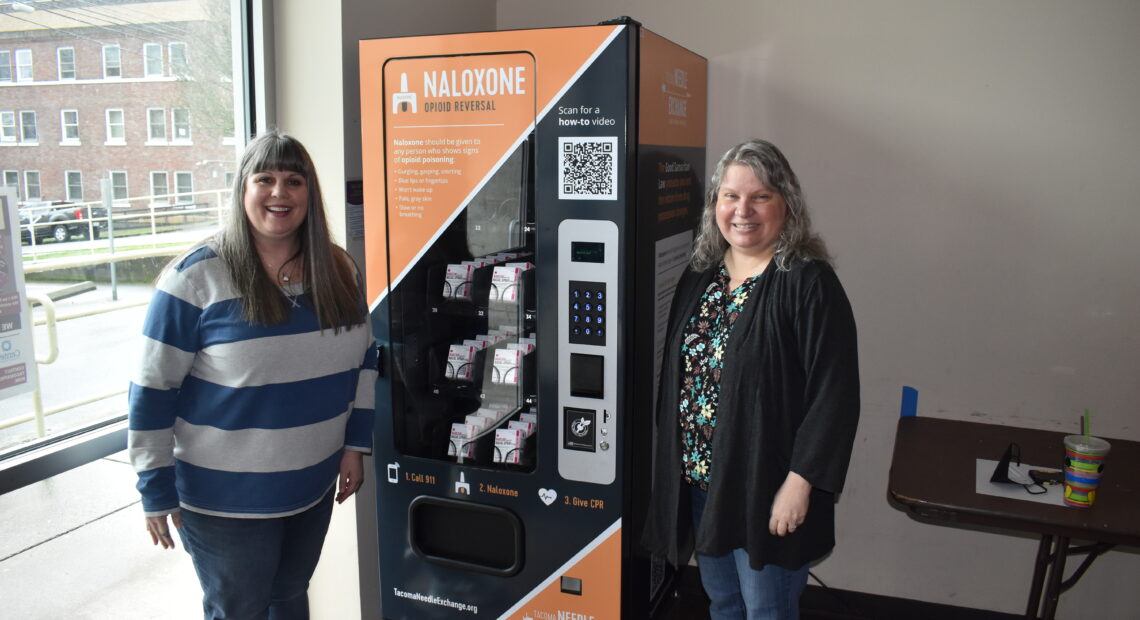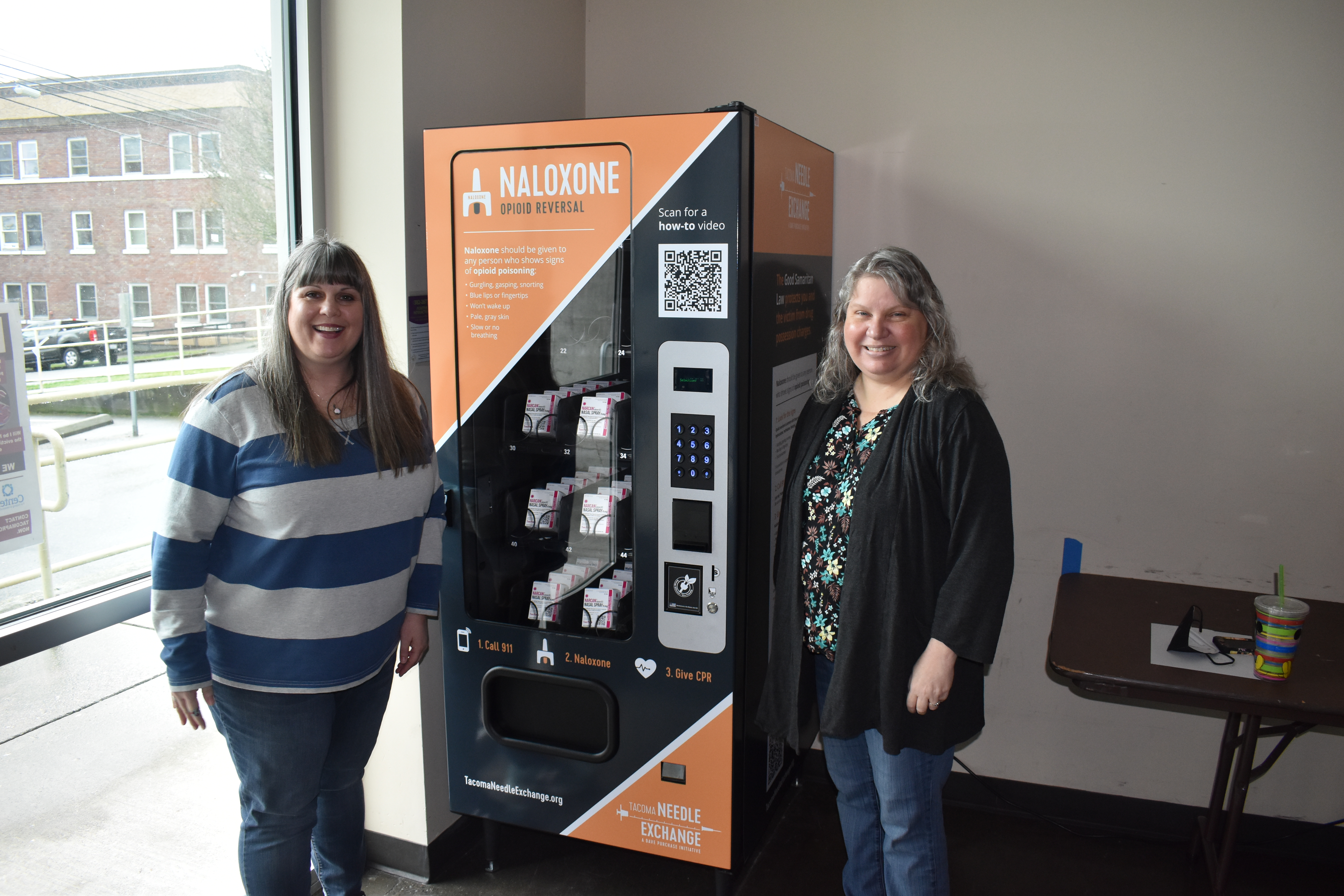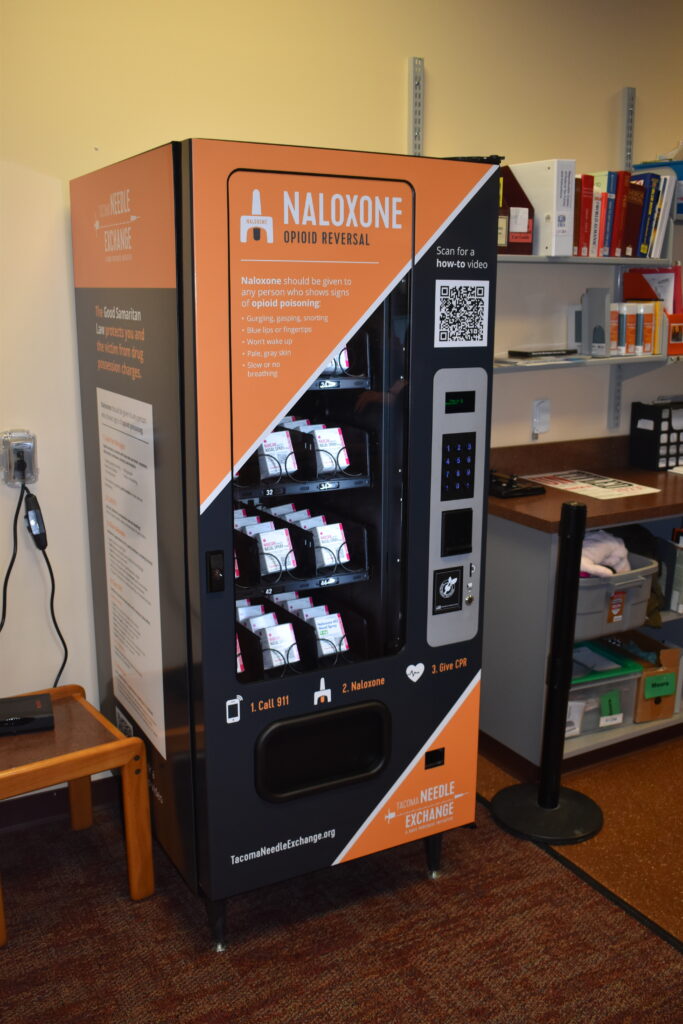
How Washington, Idaho are attempting to reduce increased opioid overdose deaths
Listen
(Runtime 3:54)
Read
By Lauren Gallup and Rachel Sun
In downtown Tacoma, Rachel Ahrens said she sees drug use and abuse frequently.
“I’ve personally seen somebody that was just slumped up against the door and looked to be like an overdose,” said Ahrens, who is the building administrator for First United Methodist Church. “I didn’t have Narcan at that time, so I wasn’t able to administer that. So I had to call 911, for them to help the individual.”
Now, Ahrens has another option. The church recently became one of three sites in Pierce County to receive a vending machine that distributes free nasal naloxone, known under the brand name Narcan. This comes from an initiative by the Dave Purchase Project, which received federal funding for the machines.
Anyone can administer nasal naloxone to someone they think might be experiencing an overdose. The opioid reversal drug works by binding to the opiate receptors in the brain and reversing the overdose.
Nora Hacker, a leader at the church, said while naloxone isn’t the ultimate solution to end drug addiction, she sees it as an important tool to access to save someone’s life.
“We know it’s not the solution, it doesn’t stop addiction. It doesn’t prevent every death even,” Hacker said. “But, everybody has more time if they don’t die.”
Opioid-related overdose is the most common accidental death in Pierce County, according to the Tacoma Pierce County Health Department website. Between 2019 and 2021, the Pierce County medical examiner recorded four times as many fentanyl-related deaths, from 34 to 154.
Fentanyl-related deaths are growing particularly quickly among young people, ages 18-24, said Elizabeth Allen, behavioral health policy coordinator for the Tacoma Pierce County Health Department. At least 60 young people died from fentanyl between January 2020 and June 2022, according to the health department website.
”We’re not alone in that we see similar trends throughout Washington state, as well as the nation,” Allen said.
Deaths from opioids are accelerating. According to the Centers for Disease Control and Prevention, Washington had a 102.3% increase in synthetic opioid deaths from 2019 to 2020, while Idaho had an increase of 78.9% during the same period.
At the Tacoma-Pierce County Opioid Task Force annual summit on Thursday, Pierce County Councilmember Jani Hitchen announced that the county will receive approximately $48.5 million over 17 years from settlements from the National Opioid Settlement.
Once local governments form an opioid abatement council, they can determine how to distribute the money, based on approved activities, including treatment and prevention for opioid addiction. Hitchen listed some of the things governments could focus on when deciding how to allocate the funding.
“Do we have Narcan or naloxone out in the community when they need it,” Hitchen suggested. “And do we have training on how to administer it?”
As local governments determine how to spend this money, communities across the nation are facing a crisis, and organizations are trying to give people more access to naloxone.
In Tacoma, the Dave Purchase Project aims to reduce harm and health consequences from drug use and abuse.
“In the last three years, I have seen the most dramatic change in drug use modalities that I’ve seen since I’ve been doing this kind of work in the mid-’90s,” said Paul LaKosky, executive director of the organization.
The organization started in 1998 with the goal of reducing HIV/AIDS transmission by providing drug users with sterile needles, according to the organization’s website. As part of this, the organization offers a needle/syringe exchange program, where it also started distributing Narcan.
“I think that the last three years, there have been a kind of confluence of events that have created this kind of perfect storm for opioid poisonings and fentanyl poisoning specifically,” LaKosky said.
LaKosky said COVID-19 was a contributing factor.
“When you suddenly are telling people ‘isolate, isolate, isolate,’ you are violating the basic tenet of harm reduction, which is never use alone,” LaKosky said.
There also has been a switch from heroin to fentanyl as the drug of choice. Fentanyl is more deadly, more potent, and easier to misuse. It’s also cheaper to distribute than heroin, LaKosky said.
Users can buy fentanyl pills between $3 and $5, LaKosky said.
“Sometimes if you buy in bulk, I guess you can get them as low as $1 apiece,” LaKosky said.
In 2017, LaKosky said, the organization conducted a survey by providing volunteer participants with test strips to see if fentanyl was in the drugs they were using. Back then, more people were trying to avoid fentanyl.
“18% of people had used fentanyl, not all deliberately, most accidentally, but a small percentage had identified fentanyl as their drug of choice,” LaKosky said. “In the latest Washington state drug user health survey, the number of people I believe that had used fentanyl had doubled and more surprising the number of people who had deliberately sought out fentanyl had increased dramatically.”
Data from test strips can provide organizations like LaKosky’s with insight into what drugs people are using, as well as alert people to what drugs they are taking.
With that increase in use and overdoses, LaKosky said it’s important to normalize Narcan being seen in public and easily accessible.
Through their initiative, the Dave Purchase Project installed three vending machines throughout Pierce County.
“You just walk up to the machine, you push a button, it dispenses for free,” LaKosky said.
Each box contains two doses of the medicine, and a QR code to scan, which links to a video on how to administer it and a survey to provide the organization data on where and how it was used.
“It’s a very, very simple way of making a huge impact on people’s lives,” LaKosky said. “Not all good things have to be complicated.”
When choosing where to distribute the machines, LaKosky said the organization wanted to find places accessible outside of the normal hours of the needle/syringe exchange sites and in a variety of locations. The Tacoma Public Library Moore Branch in South Tacoma is one such site. LaKosky’s organization trained all Tacoma librarians who were interested in how to reverse an opioid overdose.
Gabby Fuentes is a neighborhood services manager for the library. Since the machine was installed at the library in February, Fuentes said there has been an overwhelmingly positive response from the community.
“People have been telling us stories about family members who are no longer with them anymore, but they wish they had had the resource available to them before,” Fuentes said.
Fuentes said addiction doesn’t follow socioeconomic barriers, but it’s easier to see among people who are unsheltered.
“I mean, just working in libraries, it’s pretty personal,” Fuentes said. “Unfortunately, we see addiction all the time.”
So far, the machine has been well used in the library. As of the beginning of March, Fuentes said they’ve given out over 100 boxes.
“We’ve had police and fire stop by to pick up doses to have in their cars,” Fuentes said. “Social service providers are picking it up, concerned family members are picking it up.”
In Idaho, naloxone vending machines are rarer and mostly concentrated in the Boise area. Randi Pedersen, Health Program manager at the Idaho Department of Health and Welfare, said the state is working to make the opioid reversal drug accessible in other ways.
Because vending machines that distribute naloxone also are used to distribute harm reduction materials, such as sterile syringes, the machines need to be able to track utilization and require more time, money and maintenance, Pedersen said.
Tracking that utilization data for naloxone isn’t as important, Pedersen said.
“We think it’s more important to just get naloxone out into the community and reduce barriers,” she said.
Instead, Pedersen said, the department of health is moving toward distribution boxes that look similar to newspaper stands, where anyone can access naloxone for free.
While Washingtonians can get naloxone from any participating pharmacy for free, the Dave Purchase Project is trying to make this emergency resource as easy to get as possible.
“We’ve made it easy to get, it’s very low barrier and it was very deliberate,” LaKosky said.
The difficulty, LaKosky and Pedersen said, has been funding those machines.
Funding for the Dave Purchase Project’s initiative came from Carelon Behavioral Health, formerly known as Beacon Health Options, as a $200,000 grant through the federal Substance Abuse Block Grant. With that, the organization purchased the three machines for just under $5,000 each. Each unit holds 90 boxes, or 180 doses, of nasal naloxone, which costs about $50 per box, LaKosky said.
The contract for the funding ends in June, but LaKosky said the organization should have enough funding to keep the machines stocked for months after that. However, that depends on demand and changes in price.
“That’s the perpetual question with single-year grant funded initiatives,” LaKosky said. He said the organization is committed to keeping the machines stocked as long as they can raise funds.
The Idaho Department of Health and Welfare also partners with organizations in local communities through the Idaho Harm Reduction Project. One of those partners is the Latah Recovery Center in Moscow, Idaho.
Darrell Keim, the Center’s director, said the Recovery Center distributed roughly 30 doses in the past year and knows of at least seven documented uses. The Center also provides other harm reduction materials, including sterile syringes.
“We’re hoping people will enter recovery,” he said, “but we want them to remain safe and alive long enough that they get the chance to do so.”
Latah County has six nonprofits and 10 retail pharmacies that stock naloxone. In Idaho, any resident can request a prescription for naloxone at a pharmacy, and its cost is covered by Medicaid.
Keim said his staff also distributes naloxone to local bars and hotels.
Organizations can request naloxone through the department of health website, and individuals also can get naloxone mailed to them at this website or find nearby locations here.
Attitudes about recovery and support services for it are complicated and highly variable in Idaho, Keim said. Idaho also continues to classify some harm reduction materials, such as fentanyl testing strips, illegal.
At the same time, many community members are supportive of recovery efforts. The department of health also offers Narcan training, and Idaho passed legislation last year to clarify allowances for organizations to redistribute naloxone.
When the center was started in 2015, some property owners didn’t want to do business with a program for people with substance use disorders, Keim said.
“When we went to start the place,” he said, “more than a handful wouldn’t rent to us once they knew what we wanted to do.”
Bigger cities, such as Boise and Tacoma have more resources than rural areas across the Northwest. In aiming to bring resources to underserved areas in Pierce County, the Dave Purchase Project partnered with the Recovery Cafe in Orting to install the third Narcan vending machine.
“When we’re looking at the rural populations, it’s just a lack of access to services,” said Rena Thompson, executive director of the Recovery Cafe.
The cafe, in the valley below Mount Rainier, provides resources for people to heal and deal with life’s challenges, from trauma to mental health to substance use, Thompson said.
Distributing naloxone was a natural fit for the cafe, Thompson said. Its location also makes it a hub for resources in an area that is otherwise sparse on behavioral health support.
“We’re here in Orting, we are in a very rural area,” Thompson said. “We don’t have any treatment centers in Orting. To get to a treatment center, it is about a 20 to 25-minute drive for the closest one, and you can only get into those if there’s an opening.” Tacoma, the largest city in Pierce County, is approximately a 45-minute drive.

Rena Thompson shows the box, which contains two doses of Narcan. (Credit: Lauren Gallup / NWPB)
Traveling to urban areas where more resources exist is a challenge, because there’s no bus lines, and some folks might not be able to drive. Even if someone can travel, there’s not enough space at treatment centers to take everyone immediately. Treatment centers don’t take all insurance. These factors only perpetuate the problems of drug abuse, Thompson said.
When someone with a substance use disorder is ready to get treatment and not use, they are ready at that precise moment, and may struggle if they can’t get help quickly, Thompson said.
“When they’re ready, they’re ready today,” Thompson said. “And if they can’t get treatment today, that means they’re going to use again.”
Yet, behavioral health providers rarely have the immediate assistance available that people can access for other emergencies, such as a broken bone. Because of that, Narcan can mean the difference between life and death.
“If we can save that person’s life today, it doesn’t mean they’re gonna get clean today,” Thompson said, “but it means they’re not dead.”
Someone experiencing an overdose will appear unconscious and not be breathing. If someone is not overdosing, Narcan does not affect them. Professionals recommend administering the medicine and calling 911. After one dose, if someone is not revived, another dose can be administered.
Opioid use affects people from all walks of life, LaKosky said. He’s talked to parents who said they never thought they’d need Narcan, and then they found their child passed out after using.
At the health department, Allen said they work to prevent addiction by treating factors that often find a comorbidity with substance abuse, such as mental and physical health conditions. Part of that is reducing the stigma to get care.
“Even one life lost is too many,” Allen said.
Hacker and Ahrens said since the machine was installed in February, they know of at least one person whose life was saved when a friend administered Narcan. The church has had to refill the machine three times because so many people have taken the medicine.
The national crisis text line is 741-741 and the national hotline is 988. In an emergency, call 911.

















